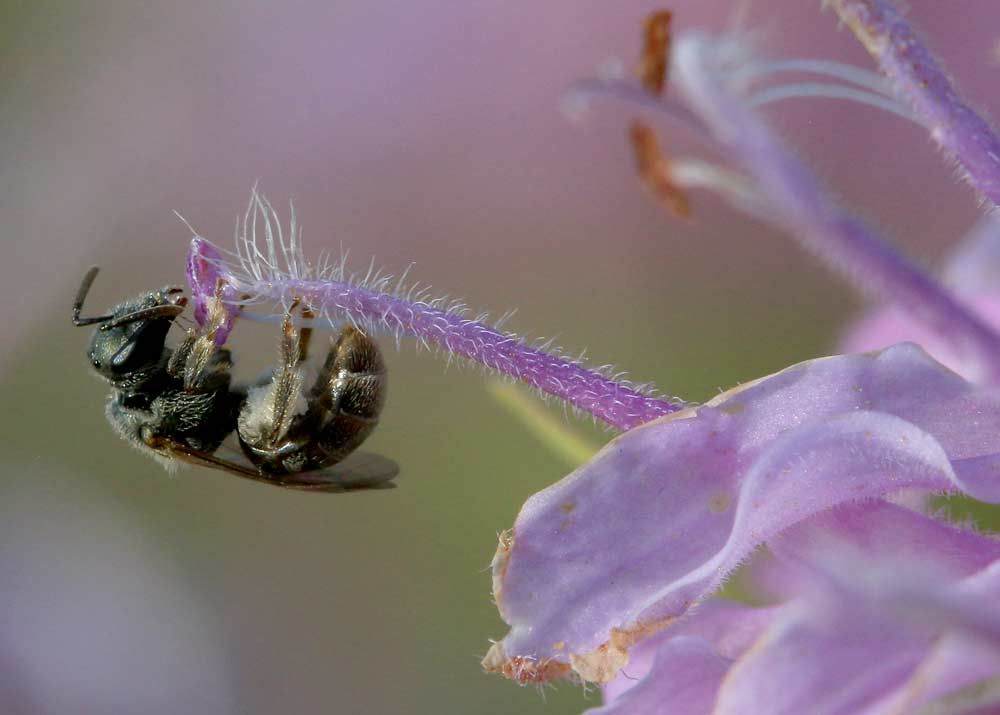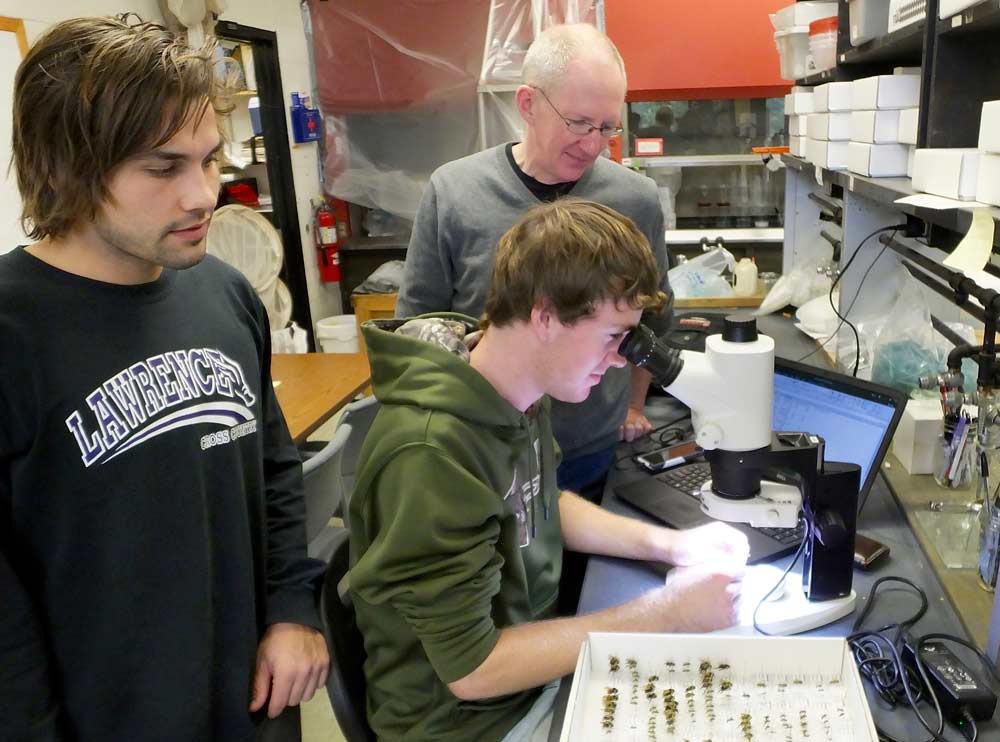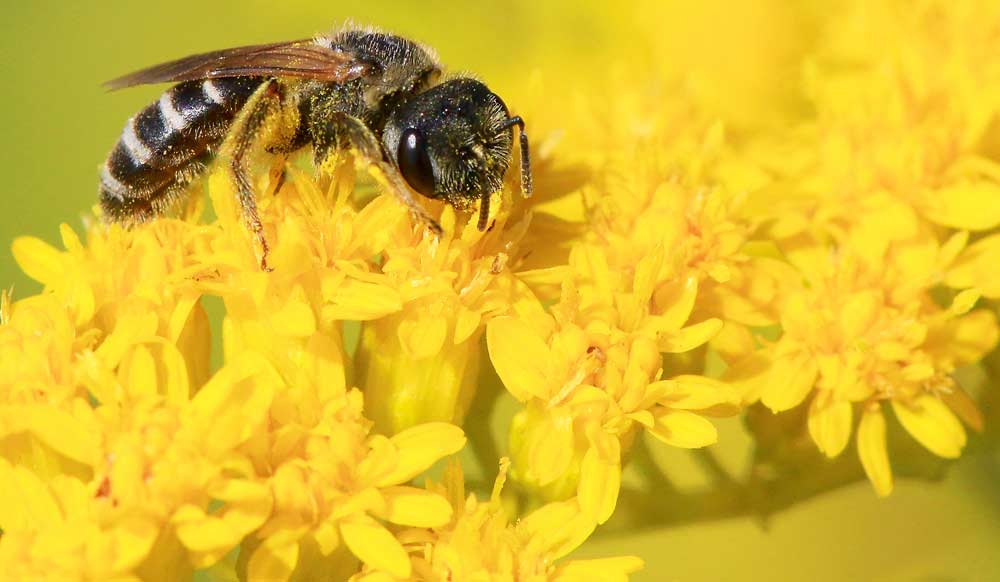
A tiny sweat bee perches on wild bergamot (Monarda fistulosa). Wild bergamot was a midsummer favorite of native bees and honeybees in the trial. (Courtesy Logan Rowe)
Numerous reports have documented declines in pollinators, especially bees, that are vital for orchards and other agricultural lands.
New research from Michigan State University is helping growers understand how to use wildflowers to help boost the numbers of these all-important insects on their acreage.
One major reason for the drop in pollinators is changing land use, according to Rufus Isaacs, professor in MSU’s Department of Entomology. Intensive farming practices over the last decade have “pushed agriculture out to the edges of fields and minimized the amount of habitat” available for wild bees and other pollinating insects, as well as natural enemies for pest control, he said.
A current project is evaluating options for plantings on farms that will return resources to support beneficial insects, he said. “What we’re trying to do in this research is to find out which plants are more rewarding for those pollinators and natural enemies, which ones will survive in Michigan soils and climates, and which ones we can integrate into plantings to support these insects,” he said.
Building on suggestions from the Michigan Native Plant Producers Association and his earlier work on native Michigan plants that promote beneficial insects, Isaacs (along with MSU entomologist Doug Landis) set out to explore optimal mixtures of plants that would provide pollen and nectar for beneficial insects from spring to fall, would be tailored to match the needs of tree fruit, blueberry and other growers, and would be easy to grow under different conditions, including the sandy, dry soils that dominate in many areas of the state.

After meticulously counting bees on each of dozens of different wildflower test plots at three sites in Michigan, the researchers then collect the insects for later identification in the lab. Here, undergraduate student Michael Killewald carefully identifies a bee species through the microscope while graduate student Logan Rowe (left) and MSU Professor Rufus Isaacs look on. (By Leslie Mertz)
“This is an attempt to expand the palette of plants so that individual growers have more options for their different settings,” he said.
Students working with Isaacs and Landis are collecting data from three sites at research stations in west-central, southwestern and northwestern Lower Michigan.
The geographic range of sites is designed to represent climate, soil and insect variations across the region. At the sites, they have four 1-meter-square plots for each of about 50 species of wildflowers.
“For three weeks while each plant is in bloom, the students are out there observing insects, counting how many they see in a specific time period, and collecting and identifying the insects to find out which insects are visiting which plants,” he said.
From this, they can determine which plants are especially attractive to bees, notably those that are good pollinators for certain cash crops, such as apples or blueberries.
Isaacs and student Logan Rowe are particularly interested in bees, and for these crucial pollinating insects, the study is showing that plant variety matters.

Based on data gathered in 2015 and 2016, including this small sample of collected bees, the study shows that beneficial insects have clear preferences for certain wildflowers. This information can help growers select a wildflower mix tailor-made for their crops and conditions. (By Leslie Mertz)
Honeybees, for instance, prefer a number of the nectar-rich plants, while most of the wild bees that are important for fruit crop pollination are primarily after pollen, he said. “We’re definitely seeing some differences there, which would suggest that you could design mixes for one kind of bee versus another kind of bee.”
Based on data collected by Rowe in both 2015 and 2016, there are clear winners during the early, middle and late growing season. Among early-season, or May- and June-blooming plants, the three top plant varieties for native bees are: hairy penstemon or beardtongue (Penstemon hirsutus); lance-leaved coreopsis (Coreopsis lanceolata), and yarrow (Achillea millefolium). Honeybees also were frequent visitors to hairy penstemon and lance-leaved coreopsis, but not to yarrow.
Midsummer plants that were popular to native bees and honeybees included: wild bergamot or bee balm (Monarda fistulosa); mountain mint (Pycnanthemum incanum); gray goldenrod (Solidago nemoralis); early goldenrod (Solidago juncea); and whorled milkweed (Asclepias verticillata). Isaacs’ group also included plots of spotted knapweed (Centaurea stoebe) in the study.
Although it is a nonnative and invasive plant, beekeepers have come to rely on this purple-flowered plant for honey production (often sold as “star thistle honey”).
He noted, “We did see some honeybees on knapweed test plots, but those plants were smaller, and there were more attracted to the mountain mint and the milkweed test plots that were in bloom at the same time.”

A sweat bee visits gray goldenrod (Solidago nemoralis). Gray goldenrod was a midsummer favorite of native bees and honey bees in the trial. (Courtesy Logan Rowe)
By far, the top plant among late-season varieties (late August through fall) was showy goldenrod (Solidago speciosa). “It was extremely attractive to native bees and honeybees. It also grew well and produced a good floral display, so part of what you’re seeing is a reflection of the sheer abundance of flowers,” he said.
Others that did well for all bees in the late season were: rosinweed (Silphium integrifolium); tall coreopsis (Coreopsis tripteris); stiff goldenrod (Solidago rigida); pale-leaved sunflower (Helianthus strumosus); silky aster (Symphyotrichum sericeum); sky-blue aster (Symphyotrichum oolentangiense); and New England aster (Symphyotrichum novae-angliae).
While growers can certainly review the full list (available online at www.nativeplants.msu.edu) and select the plants that will work best for their needs and growing conditions, Isaacs hopes seed companies will use the results to make it even simpler.
“The idea is to design a mixture of plants to support the kinds of good bugs you’re after,” he said.
That way, the grower can choose a mix of proven perennials that make sense for his or her specific orchard or field, sow the seed and reap the rewards when the insects stream into the orchards and crops once the wildflower plantings are established.
“The summer flowers help to keep bee colonies growing, which generates more queens in the fall, and hopefully more colonies the following spring. It’s all about creating the resource through the summer so these bees are more healthy and abundant next spring when the crop comes back into flower,” he said.
“With these wildflower plantings, it’s really like providing a buffet for all those beneficial insects.”
Funding for this research includes $200,000 from USDA Sustainable Agriculture Research and Michigan Extension North Central Region over three years, and $60,000 from Project GREEEN over two years. •
Plant for success
For growers who are contemplating the addition of a wildflower plot to draw beneficial insects, whether they are pollinators or natural enemies of pests, expert Rufus Isaacs of Michigan State University’s Department of Entomology offered the following suggestions:
—Pick a spot that doesn’t cut into your money-making acreage. “A lot of fruit growers have places on their farms that are frost pockets or areas of erosion concern, and in those settings, you could set up these wildflower plantings so that they would be areas that one, you don’t have to mow regularly, two, will help retain water and reduce runoff, and three, will give you a yield boost in the crops next to these plantings.”
—Shoot for 2 acres, but if you don’t have the space, go ahead with 1 acre. “Any size is going to get you some benefit, but the bigger plantings are more beneficial and easier to manage in that you get less grass encroachment. There’s also less risk of it being a place where bees or other insects go, but don’t get enough resources,” he said.
—Apply for funding to help pay for seed mixtures, which generally cost about $500-$600 per acre. The U.S. Farm Service Agency’s State Acres for Wildlife Enhancement (SAFE) program offers 90 percent of seeding costs for installing a minimum 2 acres of wildflowers on farms in 22 of Michigan’s agriculture-heavy counties in the southern lower peninsula.
The National Resources Conservation Services’ Environmental Quality Incentives Program (EQIP) also provides funding for conservation practices, including wildflower plantings, that “improve soil, water, plant, animal, air and related natural resources on agricultural land.” They also currently have a program to support honeybees on farms through plantings, cover crops, etc. in Michigan, Wisconsin, Minnesota and The Dakotas.
—Pick up a copy of Bees of the Great Lakes Region and Wildflowers to Support Them (written by Isaacs and three other MSU experts) at bit.ly/2kyPD4B, and work with a local native-plant company to select the best seed mix for insects you desire and for the soil and weather conditions on your site.
—Once you decide on the seed mix, prepare the land as needed before seeding. Once seeded, be sure to mow the area once a month during the first year, two times during the second year, and perhaps once in the third year to inhibit pre-existing weeds and allow the new wildflowers to establish themselves and dominate the plot.
—Make the most of it. Isaacs has seen a few apple orchards and vineyards get some public relations traction from wildflower plots. “A couple of the smaller you-pick farms around the state have put in these plantings, and they see them also as a way to spread a positive message about agriculture’s care of the land for their public visitors,” he remarked. “It’s hard to put a dollar figure on the value, but it’s something to think about if you’ve got the public coming to the property.”
Isaacs highlighted some other potential values of wildflower plantings for fruits. He remarked, “Perennial wildflower plantings are not going to solve all of a grower’s problems, but if you’re interested in trying to reduce your risk of either poor pollination or pest outbreaks, it’s a good option to consider.”
– by Leslie Mertz, Ph.D., a freelance writer based in Gaylord, Michigan.






Leave A Comment